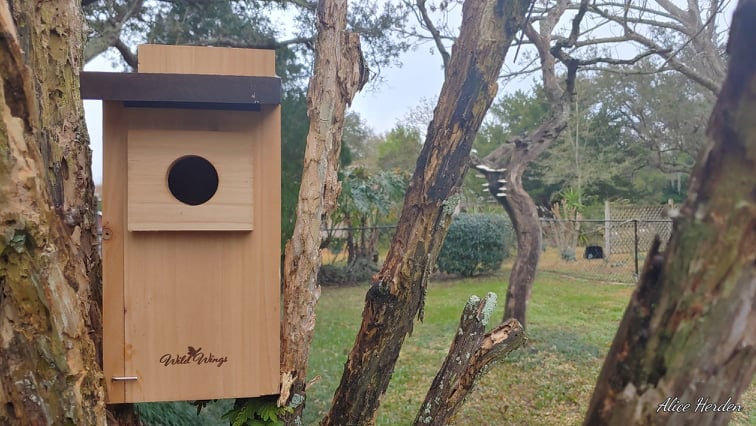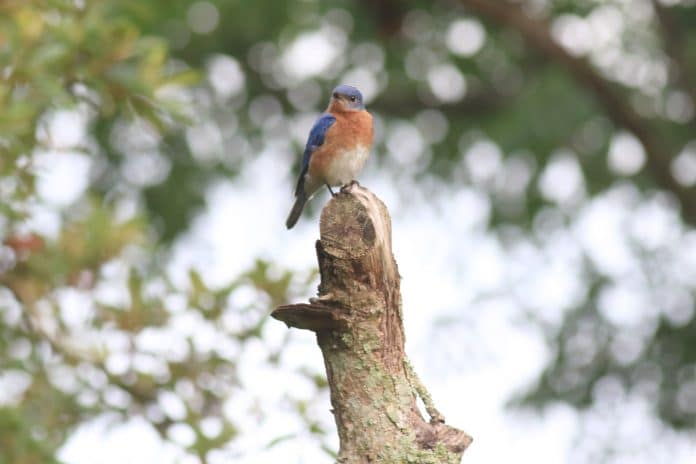Eastern bluebirds are year-round residents of Florida. They have beautiful blue plumage that spans from their head to their tail, with rusty-colored feathers on their chest. The males are a deep, chalky blue and more vibrant during mating season, while the females have a faded bluish/gray coloring. Eastern bluebirds are known as secondary-cavity nesters which means they seek out previous nesting sites excavated by primary cavity-nesting birds, like woodpeckers. Nesting cavities can be in live trees, snags (standing dead trees), or fence posts.
From the 1920s to the 1970s, their population began to decline. There was a lack of nesting sites due to territorial competition with other secondary cavity-nesters like Carolina chickadees, house wrens, and some species of owls. But that’s not all that played a role in the decline. Reduction of their natural habitat and habitat fragmentation were also big factors. Habitat fragmentation is the breaking up of a largely intact area of habitat into smaller isolated patches.
Along with the reduction of natural habitat, other factors contributing to the Eastern bluebird population decline were the loss of snags as nesting sites and the increase in predators, like cowbirds, snakes, and raccoons. Additionally they faced aggressive competitors in other bird species like house sparrows and starlings. These two bird species have been documented in killing eastern bluebirds, both adults and young in order to claim their nesting site.
In June of last year, a male eastern bluebird’s behavior caught my attention. He was checking out the snag in our backyard. This snag has previous nesting cavities and we had never noticed any birds occupying them.
Male eastern bluebirds must find a suitable home for the female to raise their young, and we were able to observe this happening in our backyard. The male would check out the pre-excavated cavity, fly away, come back and perch on the nearby branch. He would sing and flutter his wings. When the female appears, she will check the nesting site out. If she accepts then she will begin to bring nesting materials. Unfortunately, a Carolina chickadee was interested in that particular nesting site. But ultimately, a pair of downy woodpeckers moved in and raised two healthy chicks.
Quick Nature Notes about Eastern Bluebirds:
Eastern Bluebirds are a member of the Thrush family
They only weigh about an ounce- the weight of a AA battery or ten pennies
They are sexually dimorphic- meaning the male and female look different
They prefer open grassy areas
The female will build a cup-shaped nest constructed with pine needles, twigs, and grass. She will add animal hair and feathers as well.
Their nesting begins in mid-February (for Florida) and mid-September in the northern states.
Bluebirds are territorial when nesting and will re-nest two to three times per year
Females lay between three and five beautiful blue colored eggs, although there has been documentation of white eggs
Chicks will hatch within a week and fledge (leave the nest) within twenty days
Bluebirds primary diet consists of fruit and insects
They can spot an insect around 50 feet away, which is why they are classified as a sit and wait predator.
Bluebirds may rarely visit bird feeders. Providing Florida native plants that produce berries would be beneficial and limit pesticide use because, after all, eastern bluebirds and other birds need insects to survive and feed their young.
When the population of bluebirds was declining, conservation pioneers got to work in trying to preserve the species. In the 1970s, Wisconsoners began building artificial nesting sites called bluebird-boxes, to replace the loss of natural nesting sites. Their action created a new movement of building bluebird-boxes throughout the United States. Their efforts and commitment helped bring awareness to the plight of this avian species and the eastern bluebird population began to recover.
February is when bluebirds seek nesting sites and providing a nesting site on your property can help your neighboring eastern bluebirds. You can build a bluebird-box or place a prebuilt one on your property. But before you do, a couple of things to consider are location and commitment.
Location is extremely important. Eastern bluebirds need open grassy-mowed areas and the absence of/or a limited number of bird feeders for successful nesting. It is recommended that the placement of the bird-box be more than 50 feet from any scrubby or woody areas. If you decide to place more than one, the distance between the two should be 330 feet.
There are a few bird-box designs suited for bluebirds. Here is a link to a website for those that wish to build their bluebird box: https://nestwatch.org/learn/all-about-birdhouses/birds/eastern-bluebird/ or purchase a premade one from a nature/wildlife bird supply store.
Having a birdhouse also comes with a great deal of commitment and the responsibility of cleaning. After the bluebird’s chicks have all fledged, it is recommended to clean the bird box. The cleaning consists of removing any nesting materials, and this should be reasonably accessible since the height placement of the bluebird box is generally at eye level.
While the nest is in use, enjoy viewing from afar!


